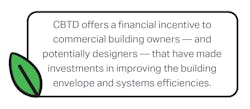TAXES & INCENTIVES | Tax deduction offers new opportunities for efficiency
Last year’s passage of the Inflation Reduction Act of 2022 (IRA) contained an important revision to the U.S. tax code’s Section 179D: Energy efficient commercial buildings deduction that expanded the Commercial Buildings Tax Deduction (CBTD). The CBTD offers a financial incentive to commercial building owners — and potentially designers — that have made investments in improving the efficiency of their interior lighting, HVAC system, hot water system, and building envelope. As a result, the CBTD may increase demand for energy-efficient LED lighting and advanced lighting controls. Here’s how it works.
Background
Created by the Energy Policy Act of 2005, the CBTD was supported by numerous industry groups, including the National Electrical Manufacturers Association and the Building Owners and Managers Association. It is an accelerated tax deduction: Instead of taking the deduction over a period of years, as is typically required, building owners can take the entire amount in a single year. The deduction is calculated as a dollar amount per square foot and earned by achieving or exceeding a target reduction in the total annual energy and power costs for the building’s interior lighting, HVAC, and hot water systems as compared to a reference building.
The CBTD has had a messy history. Over time, it frequently expired only to be reinstated, often retroactively. In 2015, a tax law updated the reference building from the 2001 to the 2007 version of the ANSI/ASHRAE/IES 90.1: Energy Standard for Buildings Except Low-Rise Residential Buildings, making the energy savings target more difficult to reach. In 2021, the Consolidated Appropriations Act made the CBTD permanent, incorporating an inflation adjustment into the incentive and authorizing the Treasury Secretary to affirm the benchmark to the latest version of standard 90.1.
In August 2022, President Biden signed the IRA into law, which significantly revised the CBTD. This law expands the availability of the incentive to more building types, including public buildings and houses of worship. It reduced the energy savings target while increasing the size of the financial incentive; and allows owners to earn the incentive on a building more than once. It requires the use of energy modeling software on all projects.
This change eliminated a former provision allowing owners to take a partial deduction if they updated individual building systems. It also eliminated the Interim Lighting Rule, which allowed for owners to meet an energy savings target simply by updating lighting systems without the need for computer modeling.
In the new CBTD, the savings target is calculated with respect to all energy consumed by the interior lighting and HVAC/hot water systems. In other words, upgrading only a building’s lighting will likely fall short of the target; it needs to be part of a more holistic building system upgrade.
CBTD provisions today
The IRA’s updates and revisions to Section 179D amend the U.S. tax code to include the following requirements and changes.
What projects qualify? Any equipment installed in a commercial building that Section 179D terms “energy-efficient commercial building property” can qualify for the CBTD. The building must fall within the scope of the 90.1 energy standard, which includes most commercial types. In the case of public buildings such as government and other tax-exempt buildings such as houses of worship, the property designer may claim the CBTD in place of the owner. The IRA tasked Treasury to update the regulations enabling designers to claim the CBTD in these cases.
What is “energy-efficient commercial building property”? This is defined as normally depreciable equipment that is 1) installed as part of interior lighting, HVAC/hot water systems, and/or the building envelope; and 2) expected to reduce total annual energy and power costs for these systems by at least 25% compared to a reference building.
What is the reference building? For new construction, this is a building that would satisfy the minimum requirements of the 90.1 energy standard (2007 version until Treasury affirms a more recent version); interested building owners should confirm what standard is in effect before starting a project. For retrofit projects, the reference building is the existing (pre-retrofit) building.
What is the incentive? The CBTD incentive is calculated as an Applicable Dollar Value (ADV) of $2.50 per square foot (SF) for achieving 25% savings against the reference building, increasing $0.10/SF for every 1% energy reduction beyond the 25% base, up to a $5/SF maximum. These rates assume prevailing wage and apprenticeship requirements are met.
If prevailing wage and apprenticeship requirements are not met, the CBTD incentive drops to $0.50/SF for the building for achieving 25% savings against the reference building, increasing $0.02/SF for every 1% energy reduction beyond the 25% base, up to a $1/SF maximum.
Is it a one-time deal? An owner can now claim the CBTD every three years for a privately owned building, four years if a tax-exempt entity, as long as the project fulfills 179D’s requirements.
How are energy savings demonstrated? The IRA instructed Treasury to publish regulations detailing methods for calculating and verifying energy and power consumption based on the California Nonresidential Alternative Calculation Method Approval Manual. It also requires Treasury to detail how to certify projects for the CBTD, including specifying qualified individuals who will determine compliance and qualified energy modeling software (at the time of publication, the software list was good only for projects in service before Jan. 1, 2021). Each certification must include an explanation of energy-efficient building features and projected annual energy costs for the owner.
What if my project is a retrofit? For retrofit projects, the reference building is the pre-retrofit building and not a theoretical benchmark based on 90.1. The design must demonstrate an expected 25% decrease in energy use intensity — measured in BTU — compared to the pre-retrofit building. A qualified retrofit plan is required, and the building must have been placed in service at least five years before producing this plan. The deduction must be taken in the year of final qualifying certification.
Lighting and advanced controls can play a part
The elimination of the old Interim Lighting Rule made lighting’s role in gaining the CBTD incentive more complex, as improving lighting efficiency to achieve the deduction will require a holistic building systems approach, not to mention the use of energy modeling software.
In new construction projects today, LED lighting and lighting controls can deliver significant energy savings compared to 90.1-2007. But achieving savings becomes more difficult when the baseline reference is energy standard 90.1-2016 or later; in particular, 90.1-2019 includes maximum interior lighting power densities based almost entirely on LED lighting and requires detailed control strategies.
To maximize energy savings, designers are encouraged to consider networked lighting controls able to implement advanced strategies, such as institutional task tuning, reduced control zoning largely at the luminaire level, and highly detailed and robust sequences of operations.
For retrofit projects, designers have more latitude based on the existing lighting system, which could make the 25% savings target easier to achieve. Here, LED lighting and advanced controls can deliver substantial energy savings, though lighting often will need to play a part in a holistic building upgrade, as again the savings target is intended to encompass the building’s interior lighting, HVAC, and hot water systems.
As with any project type or energy goal, the designer must ensure the lighting system performs its primary role of fostering an appropriate visual environment. Energy savings must be evaluated carefully against the interests of good design and the needs of building occupants. Fortunately, lighting control options providing the substantial energy savings should not compromise lighting quality if properly designed and managed.
Overall, the latest version of the CBTD offers a strong incentive to achieve a high level of energy efficiency in commercial buildings. In new buildings, it incentivizes more detailed design and advanced control options. In existing buildings, it incentivizes a wide range of lighting and advanced control options that, when coupled with available utility rebates, can substantially reduce initial cost.
CRAIG DILOUIE, LC, CLCP, is education director for the Lighting Controls Association, a council of the National Electrical Manufacturers Association dedicated to educating the public about lighting control technology and application.
For up-to-the-minute LED and SSL updates, follow us on Twitter. You’ll find curated content and commentary, as well as information on industry events, webcasts, and surveys on our LinkedIn page and our Facebook page.

Craig DiLouie
Craig DiLouie, LC, CLCP, is education director for the Lighting Controls Association, a council of the National Electrical Manufacturers Association dedicated to educating the public about lighting control technology and application. Learn more at lightingcontrolsassociation.org.






![The DesignLights Consortium continues to make progress in shifting outdoor lighting products and implementation practices toward a more restrained and thoughtful strategy. [Image does not represent a DLC qualified fixture.] The DesignLights Consortium continues to make progress in shifting outdoor lighting products and implementation practices toward a more restrained and thoughtful strategy. [Image does not represent a DLC qualified fixture.]](https://img.ledsmagazine.com/files/base/ebm/leds/image/2024/08/66be810888ae93f656446f61-dreamstime_m_265700653.png?auto=format,compress&fit=&q=45&h=139&height=139&w=250&width=250)